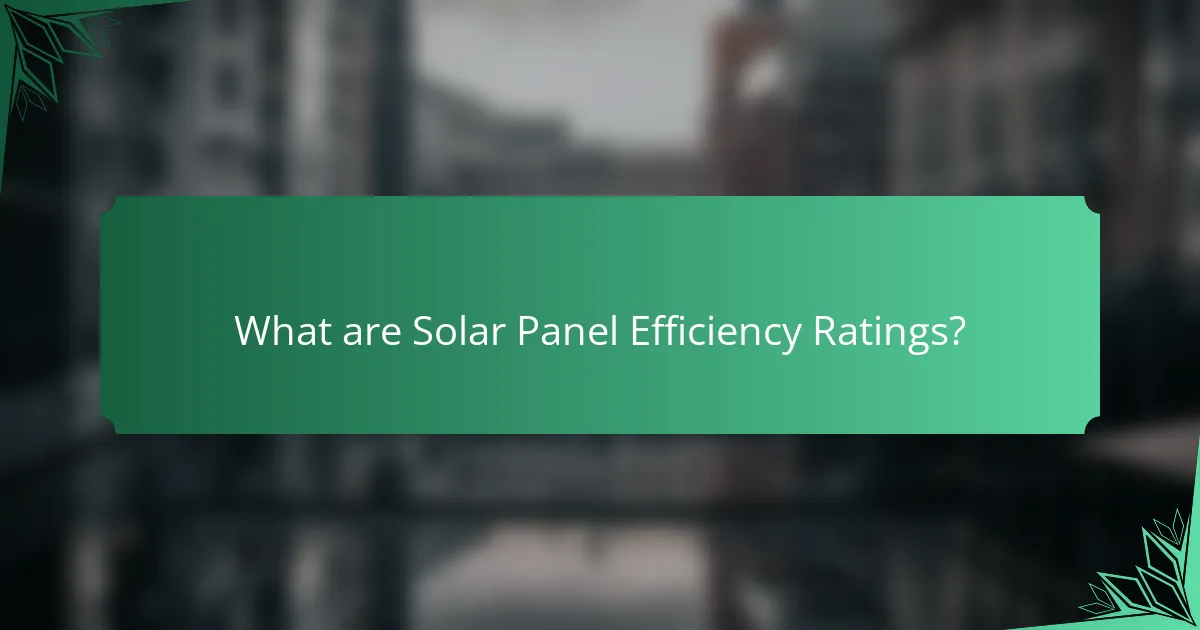
What are Solar Panel Efficiency Ratings?
Solar panel efficiency ratings measure how effectively a solar panel converts sunlight into usable electricity. These ratings are typically expressed as a percentage. For example, a panel with a 20% efficiency rating converts 20% of sunlight into electricity. Higher efficiency ratings indicate better performance in converting solar energy. Most modern panels range from 15% to over 22% efficiency. Efficiency ratings are determined through standardized testing procedures, such as those outlined by the International Electrotechnical Commission (IEC). These tests assess factors like temperature and light conditions. Consequently, efficiency ratings help consumers compare solar panel performance and suitability for various climates.
How are Solar Panel Efficiency Ratings determined?
Solar panel efficiency ratings are determined by measuring the amount of sunlight converted into usable electricity. This process typically involves standardized testing procedures. The most common standard is set by the International Electrotechnical Commission (IEC), specifically IEC 61215. During testing, panels are exposed to a specific amount of sunlight, usually 1000 watts per square meter. The output power is then measured under controlled conditions. The efficiency is calculated by dividing the electrical output by the incident sunlight energy. For example, a panel that produces 300 watts under these conditions has an efficiency of 18% if its area is 1.67 square meters. This rating allows consumers to compare different solar panels effectively.
What metrics are used to measure efficiency in solar panels?
The primary metrics used to measure efficiency in solar panels include conversion efficiency, fill factor, and power output. Conversion efficiency indicates the percentage of sunlight converted into usable electricity. It typically ranges from 15% to 22% for commercial panels. Fill factor measures the quality of the solar cell and is calculated by the ratio of maximum power output to the product of open-circuit voltage and short-circuit current. A high fill factor, usually above 75%, indicates better performance. Power output is measured in watts and reflects the total electricity generated under standard test conditions. These metrics collectively provide a comprehensive assessment of solar panel efficiency.
How does the efficiency rating impact solar panel performance?
The efficiency rating directly impacts solar panel performance by determining how much sunlight can be converted into usable electricity. Higher efficiency ratings mean that a solar panel can produce more energy from the same amount of sunlight. For example, a solar panel with a 20% efficiency rating converts 20% of sunlight into electricity, while a 15% efficient panel converts only 15%. This difference can lead to significant variations in energy output. In practical terms, higher efficiency panels require less space to generate the same amount of energy as lower efficiency panels. Additionally, efficiency ratings influence the overall cost-effectiveness of solar installations. According to the National Renewable Energy Laboratory, higher efficiency panels can lead to lower long-term energy costs due to increased energy production. Thus, the efficiency rating is a critical factor in assessing solar panel performance.
Why are Solar Panel Efficiency Ratings important?
Solar panel efficiency ratings are important because they indicate how effectively a solar panel converts sunlight into electricity. Higher efficiency ratings mean more energy production in a given space. This is crucial for optimizing limited rooftop areas. Efficient panels can lead to lower energy costs over time. For instance, a panel with a 20% efficiency rating generates more electricity than one with 15%. This efficiency also affects the overall return on investment for solar systems. Additionally, in regions with limited sunlight, high-efficiency panels can perform better than lower-rated alternatives. Therefore, efficiency ratings directly impact energy output and financial viability.
How do efficiency ratings affect energy output?
Efficiency ratings directly influence the energy output of solar panels. Higher efficiency ratings indicate that a solar panel converts a greater percentage of sunlight into usable electricity. For example, a panel with a 20% efficiency rating generates more energy than one with a 15% rating under the same conditions. This translates to more electricity production per square meter of solar panel installed. In practical terms, a higher efficiency rating can lead to reduced installation space requirements for the same energy output. Furthermore, efficiency ratings can vary based on climate conditions. Panels may perform differently in extreme temperatures or varying sunlight levels, impacting overall energy output. Thus, choosing solar panels with higher efficiency ratings is crucial for maximizing energy production.
What role do efficiency ratings play in consumer decision-making?
Efficiency ratings significantly influence consumer decision-making regarding solar panels. These ratings provide a clear metric for comparing the energy output of different solar panel models. Higher efficiency ratings indicate that a panel converts more sunlight into electricity. This can lead to lower energy costs and faster return on investment. Consumers often prioritize efficiency ratings to ensure they maximize their energy production in limited space. Research shows that consumers are willing to pay more for higher-rated panels due to perceived long-term savings. This trend is supported by data from the National Renewable Energy Laboratory, which indicates that efficiency directly correlates with overall performance and consumer satisfaction. Thus, efficiency ratings serve as a critical factor in guiding consumer choices in the solar panel market.

How do Solar Panels perform in different climates?
Solar panels perform variably across different climates. In sunny climates, solar panels generate maximum energy due to high sunlight exposure. For instance, locations like Arizona can achieve efficiencies exceeding 20% during peak sunlight hours. In colder climates, solar panels can still function effectively, as they are more efficient at lower temperatures. Research indicates that solar panels can produce energy even in snowy conditions, with the snow helping to keep them clean. However, in extremely humid or rainy climates, efficiency may decrease due to cloud cover and reduced sunlight. In such regions, solar panels may still generate energy, but at lower rates compared to sunnier areas. Overall, solar panel performance is influenced by factors such as sunlight availability, temperature, and weather conditions.
What factors influence solar panel performance in various climates?
Solar panel performance is influenced by factors such as temperature, sunlight intensity, humidity, and precipitation. Higher temperatures can reduce efficiency due to increased resistance in solar cells. Conversely, cooler temperatures can enhance performance. Sunlight intensity directly correlates with energy production; more sunlight results in higher output. Humidity can affect the amount of sunlight reaching the panels, impacting their overall efficiency. Precipitation, while generally beneficial for cleaning panels, can also reduce sunlight exposure during cloudy or rainy conditions. Each climate presents unique challenges and advantages that affect solar panel output and efficiency.
How does temperature affect solar panel efficiency?
Temperature negatively affects solar panel efficiency. As temperature increases, the performance of solar panels typically decreases. Most solar panels operate best at cooler temperatures. High temperatures can lead to a reduction in voltage output. This reduction can impact overall energy production. For example, a temperature increase of 1°C can decrease efficiency by approximately 0.5%. This phenomenon is due to the semiconductor materials used in solar cells. These materials have a temperature coefficient that indicates their performance drop with rising temperatures. Therefore, maintaining optimal temperatures is crucial for maximizing solar panel efficiency.
What is the impact of humidity on solar panel performance?
Humidity can negatively impact solar panel performance. High humidity levels can lead to increased moisture on the panels. This moisture can reduce the amount of sunlight reaching the surface. Consequently, solar energy conversion efficiency may decline. Additionally, humidity can promote the growth of algae and mold. These growths can further obstruct sunlight absorption. Research indicates that solar panels in humid climates may experience a decrease in output by 10-20%. This reduction is particularly evident in regions with high humidity and low sunlight.
Which climates are most suitable for solar panel installation?
The most suitable climates for solar panel installation are those with high solar irradiance and minimal cloud cover. These conditions maximize energy production from solar panels. Sunny and dry regions, such as deserts, are ideal. Locations like the southwestern United States experience long hours of sunlight. Tropical climates also support solar efficiency, provided they have consistent sun exposure. However, excessive humidity can affect performance. Temperate climates can be suitable as well, especially during sunny seasons. Areas with significant rainfall or frequent snow may reduce solar efficiency. Overall, optimal climates feature abundant sunshine and moderate temperatures for effective solar energy capture.
How do solar panels perform in arid versus humid environments?
Solar panels generally perform better in arid environments than in humid ones. In arid regions, solar panels benefit from higher sunlight exposure and less atmospheric moisture. This leads to increased energy production. Conversely, humid environments can reduce solar panel efficiency due to factors like cloud cover and increased humidity levels. High humidity can also lead to condensation, which may cause corrosion or damage to the panels over time. Research indicates that solar panels can lose up to 20% efficiency in high-humidity conditions compared to their performance in arid climates.
What adaptations are needed for solar panels in extreme weather conditions?
Solar panels require specific adaptations to function effectively in extreme weather conditions. These adaptations include enhanced durability to withstand high winds and hail. Panels may be constructed with stronger materials to resist physical damage. Furthermore, they can be designed with improved waterproofing to prevent water ingress during heavy rainfall. Increased temperature tolerance is essential for areas with extreme heat. Some solar panels incorporate cooling technologies to maintain efficiency in high temperatures. In snowy regions, panels may have a sloped design to facilitate snow removal. Additionally, anti-reflective coatings can improve performance in low-light conditions. These adaptations ensure solar panels maintain efficiency and longevity in diverse climates.

What is the adaptability of solar panels?
Solar panels exhibit high adaptability to various environments and conditions. They can function efficiently in diverse climates, including hot, cold, and humid conditions. Solar panels are designed to capture sunlight effectively, regardless of temperature fluctuations. Their efficiency can be optimized through different mounting systems, such as fixed or tracking mounts. Additionally, advancements in technology enable solar panels to perform well in shaded areas. Studies have shown that modern solar panels can maintain efficiency levels above 80% in less-than-ideal conditions. This versatility makes solar panels suitable for residential, commercial, and industrial applications worldwide.
How can solar panels be adapted for different installation requirements?
Solar panels can be adapted for different installation requirements through various methods. These include adjusting the tilt angle to optimize sunlight exposure. Different mounting systems accommodate roofs, ground installations, or even portable setups. Flexible solar panels can conform to irregular surfaces, enhancing versatility. Additionally, microinverters or power optimizers can be used to maximize energy output in shaded areas. Customization options, such as bifacial panels, can capture sunlight from both sides. These adaptations ensure efficiency across diverse environments and installation contexts.
What are the various types of solar panel systems available?
The various types of solar panel systems available include grid-tied, off-grid, and hybrid systems. Grid-tied systems connect directly to the utility grid. They allow for net metering, which credits excess energy produced. Off-grid systems operate independently from the grid. They require battery storage to supply power when solar generation is low. Hybrid systems combine both grid-tied and off-grid features. They offer flexibility with battery backup while being connected to the grid. Each system type caters to different energy needs and installation environments.
How do mounting options impact solar panel adaptability?
Mounting options significantly impact solar panel adaptability. Fixed mounts limit the angle and orientation of solar panels, reducing their ability to capture sunlight effectively throughout the day. Adjustable mounts allow for changes in angle, enhancing energy capture during varying seasons. Tracking mounts can follow the sun’s path, maximizing solar exposure and efficiency.
In diverse climates, adaptable mounting systems can optimize performance by adjusting to local weather conditions. For instance, in snowy regions, specific mounts can prevent snow accumulation on panels, ensuring consistent energy production. Research indicates that solar panels with adjustable or tracking mounts can increase energy capture by 20% to 50% compared to fixed mounts. Thus, the choice of mounting option is crucial for maximizing solar panel performance and adaptability in varying environments.
What innovations are enhancing solar panel adaptability?
Innovations enhancing solar panel adaptability include bifacial solar panels and flexible solar cells. Bifacial panels capture sunlight from both sides, increasing energy output by up to 30%. Flexible solar cells, made from materials like organic photovoltaics, can be applied to various surfaces, including curved structures. Another innovation is the integration of solar tracking systems, which adjust the panel’s angle to follow the sun, improving efficiency by 25% or more. Additionally, advancements in AI and machine learning optimize energy production by predicting weather patterns. These innovations collectively enhance the versatility and efficiency of solar panels across different environments.
How do flexible solar panels differ from traditional panels?
Flexible solar panels differ from traditional solar panels primarily in their construction and application. Traditional panels are rigid and typically made from crystalline silicon. They are heavier and require specific mounting systems for installation. In contrast, flexible solar panels use thin-film technology, allowing them to be lightweight and bendable. This flexibility enables installation on a variety of surfaces, including curved or irregular shapes.
Additionally, flexible panels can be integrated into products like backpacks or vehicles. Their efficiency ratings may vary, but they often perform better in low-light conditions compared to traditional panels. Flexible panels also tend to be less durable and may have a shorter lifespan than their traditional counterparts.
What role does technology play in improving solar panel performance across climates?
Technology enhances solar panel performance across various climates by optimizing energy conversion and durability. Innovations such as bifacial solar panels capture sunlight from both sides, increasing energy yield. Advanced materials, like perovskite solar cells, improve efficiency in lower light conditions. Tracking systems adjust panel angles to maximize sun exposure throughout the day. Additionally, integrated cooling technologies prevent overheating, maintaining efficiency in hot climates. Smart monitoring systems allow for real-time performance analysis and maintenance alerts. Research from the National Renewable Energy Laboratory indicates that these technologies can increase overall energy output by up to 30%. Thus, technology plays a crucial role in adapting solar panels to diverse environmental conditions.
What are the best practices for maximizing solar panel efficiency?
To maximize solar panel efficiency, ensure optimal positioning and regular maintenance. Panels should be installed at an angle that captures maximum sunlight. This angle varies based on geographic location. Keeping panels clean enhances their performance by preventing dirt buildup. Regular inspections can identify shading issues from nearby trees or buildings. Investing in high-efficiency solar panels increases energy output. Monitoring system performance helps detect and address inefficiencies promptly. Research indicates that well-maintained systems can produce up to 25% more energy.
How can homeowners optimize solar panel placement for better performance?
Homeowners can optimize solar panel placement by ensuring panels face true south in the Northern Hemisphere. This orientation maximizes sunlight exposure throughout the day. Additionally, homeowners should install panels at an angle that matches their latitude for optimal performance. Keeping panels free from shade is crucial, as even small obstructions can significantly reduce efficiency. Regular cleaning of panels helps maintain their performance by removing dirt and debris. Homeowners should also consider local climate conditions, as regions with more sunlight benefit from different placement strategies compared to cloudier areas. According to the U.S. Department of Energy, proper placement can increase solar panel efficiency by 20% to 30%.
What maintenance tips can enhance the longevity and efficiency of solar panels?
Regular cleaning of solar panels enhances their efficiency. Dirt, dust, and debris can block sunlight, reducing energy output. Cleaning panels every six months is recommended. Use a soft brush or sponge with mild soap and water. Avoid harsh chemicals that can damage the surface. Inspect for any physical damage or wear regularly. Look for cracks or loose connections that may affect performance. Ensure surrounding vegetation is trimmed to prevent shading. Check the inverter and wiring for any signs of malfunction. Keeping records of performance can help identify issues early. These practices can significantly extend the lifespan and efficiency of solar panels.
Solar panel efficiency ratings are critical metrics that measure how effectively solar panels convert sunlight into usable electricity, typically expressed as a percentage. The article explores how these ratings are determined, the metrics used to assess efficiency, and their impact on solar panel performance in various climates. It also discusses the adaptability of solar panels to different environmental conditions, including innovations that enhance their efficiency and best practices for maximizing performance. Key factors such as temperature, humidity, and installation methods are examined to provide a comprehensive understanding of solar panel efficiency and effectiveness across diverse settings.